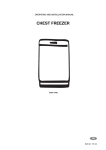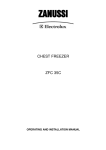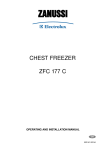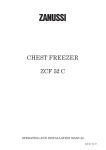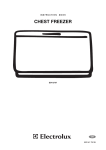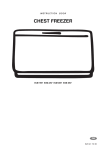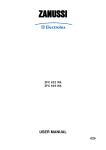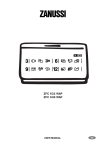Download Zanussi ZFC 35C Installation manual
Transcript
ZANUSSI CHEST FREEZER ZFC 35 C ZFC 11 JE OPERATING AND INSTALLATION MANUAL Important Safety Information These warnings are provided in the interests of your safety. Ensure that you understand them all before installing or using this appliance. Your safety is of paramount importance. If you are unsure about any of the meanings or these warnings contact your Local Service Force Centre. Prior to Installation Check the appliance for transport damage. Under no circumstances should a damaged appliance be installed. In the event of damage please contact your retailer. Installation This appliance is heavy. Care should be taken when moving it. It is dangerous to alter the specifications or attempt to modify this product in any way. Ensure that the appliance does not stand on the electrical supply cable. If the supply cable is damaged, it must be replaced by a cable available from your local Service Force Centre. Any electrical work required to install this appliance should be carried out by a qualified electrician or competent person. Parts which heat up should not be exposed. Whenever possible, the back of the appliance should be close to a wall, but leaving the required distance for ventilation, as stated in the installation instructions. The appliance should be left for 2 hours after installation before it is turned on, in order to allow the refrigerant to settle. Make sure that the power plug is not squashed or damaged by the back of the fridge/freezer. - A damaged power plug may overheat and cause a fire. Do not place heavy articles or the fridge/freezer itself on the power cord. - There is a risk of a short circuit and fire. Do not remove the power cord by pulling on its lead, particularly when the fridge/freezer is being pulled out of its niche. - Damage to the cord may cause a short-circuit, fire and/or electric shock. - If the power cord is damaged, it must be replaced by a certified service agent or qualified service personnel. If the power plug socket is loose, do not insert the power plug. - There is a risk of electric shock or fire. Child Safety Do not allow children to tamper with the controls or play with the product. There is a risk of suffocation! Keep packaging material away from children! 2 During Use This appliance is designed for domestic use only, specifically for the storage of edible foodstuffs. It is not intended for commercial or industrial use. Containers with flammable gases or liquids can leak at low temperatures. Do not store any containers flammable materials, such as spray cans, fire extinguisher refill cartridges etc. in the refrigerator. Frozen food should not be refrozen once it has thawed out. Do not place carbonated or fizzy drinks in the freezer compartment Ice lollies can cause 'frost/freezer burns' if consumed straight from the freezer Do not remove items from the freezer compartment if your hands are damp/wet, as this could cause skin abrasions or frost/freezer burns. Bottles and cans must not be placed in the freezer compartment they can burst when the contents freeze. Manufacturers' recommended storage times should be adhered to. Refer to relevant instructions. Maintenance and Cleaning Before cleaning, always switch off the appliance and disconnect from the electrical supply. When unplugging always pull the plug from the mains socket, do not pull on the cable. Servicing This product should be serviced by an authorised engineer and only genuine spare parts should be used. Under no circumstances should you attempt to repair the appliance yourself. Repairs carried out by inexperienced persons may cause injury or serious malfunctioning. Contact your Local Service Force Centre. At the end of the Appliance Life When disposing of your appliance use an authorised disposal site. Remove the plug and ensure that any locks or catches are removed, to prevent young children being trapped inside. Contents Instructions for the User Instructions for the Installer Important Safety Information 2 Technical Specifications 8 Description of the Appliance 4 Installation Positioning 8 Electrical Connections 9 Operation Before use Starting the Appliance Temperature Control Opening/Closing the Lid Freezing Fresh Food Frozen Food Storage Thawing 5 5 5 5 5 5 6 Hints and Tips Normal Operating Sounds Food Storage Energy Saving Advice In the Event of a Power Failure 6 6 6 6 Defrosting 7 Maintenance and Cleaning Internal Cleaning External Cleaning When the Appliance is not in Use 7 7 7 Something Not Working 8 The symbol on the product or on its packaging indicates that this product may not be treated as household waste. Instead it shall be handed over to the applicable collection point for the recycling of electrical and electronic equipment. By ensuring this product is disposed of correctly, you will help prevent potential negative consequences for the environment and human health, which could otherwise be caused by inappropriate waste handling of this product. For more detailed information about recycling of this product, please contact your local city office, your household waste disposal service or the shop where you purchased the product. 3 Description of the Appliance A - Knob of temperature regulator B - Compartment for frozen food storage and freezing fresh foods 4 Operation Before Use Remove all packaging and securing tapes. Wash inside the appliance with lukewarm water and bicarbonate of soda (5m1 to 0.5 litre of water). Do not use soap or detergent as the smell may linger. Dry thoroughly. Starting the Appliance Insert the plug into the wall socket. Switching on freezer box Close top of freezer box installed in accordance with specifications down then connect equipment with mains as specified above. At this time electric components inside will be energised. Adjust knob of temperature regulator in centre with rotating clockwise. After a weak clicking cooling compressor will start together with slight vibration and noise. TEMPERATURE CONTROL The thermostat ensures that the required temperature is maintained in the freezer. Turning the thermostat button towards “ ” makes the temperature in the freezer colder, and turning the button towards “ ” makes the temperature warmer. The correct setting can be found by measuring the temperature of the top package in the middle of the freezer. This should not have a temperature higher than –18°C. A minimum clearance of 12 cm is required behind the chest freezer to allow adequate clearance for the lid to open to its full extent. The lid is not counter balanced and should be in the fully open position (passed the 90 degree upright position) or supported by the user when gaining access to the freezer, otherwise there is a risk of the lid falling closed again presenting a risk to the user. Do not force the lid past its fully open position otherwise damage could occur to the lid or hinge arrangement. Freezing Fresh Food It is important that fresh food placed in the freezer is frozen quickly and that the food already in the freezer is heated as little as possible. If more than 3-4kg of food is to be frozen: Turn the thermostat control knob to the coldest setting “ ” The freezer will now run continuously, creating a sufficient reserve of the temperature required. Turn the thermostat control knob 6-24 hours before placing new food in the freezer, depending on how much food is to be frozen. Place the food in the freezer and leave the thermostat set at “ ” for about 24 hours more. Then turn the thermostat control knob back again. The freezer will return to normal storage temperature. If the thermostat control knob is accidentally left at the coldest setting the freezer will not be damaged, but energy will be wasted. Frozen Food Storage Opening/Closing the Lid The lid is fitted with a tightly closing sealing strip to prevent moisture entering the freezer, increasing the amount of frost formed. When the lid is opened the air inside the freezer becomes slightly warmer and expands. When the lid is closed again the air is cooled immediately. This may lead to the creation of a vacuum which makes it hard to open the lid again immediately. This is quite normal. Wait for a few minutes until the vacuum has subsided and then open gently. Never use excessive force on the handle. Top has closed and opened position. Movement over open position of top (about 95°) can cause damage. Important Care should be taken when opening the lid of the freezer. When first starting the freezer or if the freezer has been out of use for some time, we advise you to run your appliance for at least 2 hours before storing frozen food. Do not exceed the storage period indicated by the manufacturer. Do not open the lid frequently or leave it open longer than is necessary. Important Do not put carbonated liquids in the freezer. Ice lollies, if consumed immediately after removal from the freezer can cause a low temperature skin burn. Do not remove items from the freezer if your hands are damp/wet, as this could cause skin abrasions or frost/freezer burns. In the event of a power cut the food in the freezer will not be affected if the power cut is short and the freezer is full. Do not open the lid Should the food begin to thaw it must be consumed quickly 5 and must not be re-frozen. (See Hints and Tips) Thawing Deep frozen or frozen food, prior to being used, can be thawed in the fridge or at room temperature, depending on the time available. Small food items may even be cooked from frozen, in this case cooking will take longer. Any frozen food which is allowed to thaw accidentally should either be eaten as soon as possible, or thrown away. Alternatively, if the food is uncooked and has not been completely defrosted it can be cooked and then refrozen. Defrosted cooked food must never be refrozen. Hints & Tips Normal Operating Sounds You may hear faint gurgling or bubbling sounds when the refrigerant is pumped through the coils or tubing. When the compressor is on, the refrigerant is being pumped round and you will hear a whirring sound or pulsating noise from the compressor. A thermostat controls the compressor and you will hear a faint `click' when the thermostat cuts in and out. Food Storage To obtain the best performance from your freezer: Do not store warm food or evaporating liquid. Avoid buying frozen food if you cannot store it straight away. The use of an insulated container is advisable. When you arrive home, place the frozen food in the freezer immediately. Do not push food together too much, try to allow air to circulate around each item. Do not store food uncovered. Ensure that food placed in the freezer is dated and labelled and used in date order to ensure that food is consumed at its best. Lean food keeps better and longer than fatty food, salt reduces the storage time. Wrap the food in polythene or aluminium freezing bags or foil so that they adhere to the food and provide an airtight seal. Packaging which is swollen or has traces of refrozen water droplets on the pack could indicate that the product has not been kept at a suitable temperature and that it may have lost its original 6 quality. Partially thawed food must not be refrozen, it must be consumed within 24 hours. Never exceed the storage times indicated by the manufacturer. Energy Saving Advice Do not install the appliance close to sources of heat, such as a boiler or radiator. Locate the appliance in a cool well ventilated room and make sure that the air openings of the appliance are not obstructed. Avoid unnecessary frosting in the cabinet by packing all foodstuffs into airtight packages before placing them in the freezer. Food which is to be frozen (when cool) should be placed in the fridge before being transferred to the freezer. Try to avoid keeping the lid open for long periods or opening the lid too frequently as warm air will enter the cabinet and cause the compressor to switch on unnecessarily often. Ensure there are no obstructions preventing the lid from closing properly. In the Event of a Power Failure If there is a power failure during the storage of frozen foods, keep the lid closed. If the temperature within your freezer should rise, do not refreeze the food without checking its condition. The following guidelines should assist you: Ice cream: Once thawed should be discarded. Fruits & Vegetables: If soft should be cooked and used up. Breads & Cakes: Can be refrozen without danger. Shellfish: Should be refrigerated and used up quickly. Cooked Dishes: i.e. casseroles should be refrigerated and used up. Large Pieces of Meat: Can be refrozen providing there are still ice crystals remaining within them. Small Joints: Should be cooked and can then be refrozen as cooked dishes. Chicken: Should also be cooked and refrozen as a fresh dish. Defrosting Maintenance and Cleaning The freezer compartment will become progressively covered with frost. This should be removed with the special plastic scraper provided whenever the thickness of frost exceeds 1 /4". During this operation it is not necessary to switch off the power supply or to remove the foodstuffs. However, when the ice becomes very thick on the inner liner, complete defrosting should be carried out and it is advisable to perform this operation when the appliance is empty. ) To carry out complete defrosting: 1. Disconnect the freezer from the electricity supply. 2. Remove any stored food, wrap in several layers of newspaper and store in a cool place. 3. Leave the lid open. 4. To accelerate the defrosting process place a bowl of hot (not boiling) water inside the freezer and close the lid. 5. When defrosting is completed, dry the interior thoroughly. 6. Turn the thermostat control back to a medium setting between 3-4 and leave to run for at least 2 hours. 7. Replace the previously removed food. Before any maintenance or cleaning is carried out you must DISCONNECT the appliance from the electricity supply Internal Cleaning Clean the inside and accessories with warm water and bicarbonate of soda (5m1 to 0.5 litre of water). Rinse and dry thoroughly. NEVER use detergents, abrasive powders, highly perfumed cleaning products or wax polishes to clean the interior as these will damage the surface and leave a strong odour. External Cleaning Wash the outer cabinet with warm soapy water. When the Appliance is not in Use When the appliance is not in use for long periods, disconnect from the electricity supply, empty all foods and clean the appliance, leaving the lid open to prevent unpleasant smells. Important A temperature rise of the frozen food packs during defrosting may shorten their safe storage life. Never use sharp metal tools to scrape off frost from the evaporator as this could damage the appliance beyond repair. Something Not Working If the appliance is not working correctly, please carry out the following checks before calling out an engineer. Defect: Check if: Possible cause: Freezer not cold enough Temperature of stored foods Plug not connected correctly increases (becomes hotter). Defect in switch or fuse Power failure Too much frost formed Lid does not close Lid in contact with goods in completely freezer Lot of moisture in the room Moisture from washing machine, tumble-dryer, etc. Goods packed poorly Lot of moisture from goods Action: Check plug and socket Check fuse, call electrician Wait until power is restored Re-arrange goods, check that lid closes correctly Move freezer to a room with less moisture, or air regularly Re-pack goods, see under “How to use” If after all above checks there is still a fault, contact your local Service Force Centre. In-guarantee customers should ensure that the above checks have been made, as the engineer will make a charge if the fault is not a mechanical or electrical breakdown. Please note that proof of purchase is required for any in-guarantee service calls. 7 Technical Specifications ZFC 35C Model Volume (gross) Volume (net) Height Width Depth Weight Energy consumpt./24h Freezing capacity Hold-over time Rated power Voltage Climatic class litres litres cm cm cm kg kWh kg/24h hours W Volts 105 102 85 55 59,3 27 0,684 12 26 66 230 SN ZFC 11 JE CFI 105 105 102 85 55 59,3 27 0,569 12 26 66 230 SN Installation Positioning Place the freezer horizontally on a firm surface, resting on all four feet. Use a wooden block or similar object to compensate for any bumps/holes in the surface. The room should be dry and adequately ventilated. Temperatures of the external environment have an impact on the energy consumption of the device. Therefore: -do not put the device to a place exposed to sunshine ore besides a radiator or oven, -put it to a place where the temperature of the environment corresponds to the climatic classification for which the device was designed. Climatic classification Ambient temperature limits SN from +10°C to +32°C N from +16°C to +32°C ST from +18°C to +38°C T from +18°C to +43°C If the freezer has been handled standing on end it should be allowed to stand in normal position for about 12 hours before switching it on. Please ensure that when the appliance is installed it is easily accessible for the engineer in the event of a breakdown. 8 Electrical Connection Any electrical work required lo Install this appliance should be carried out by a qualified electrician or competent person. This appliance must be earthed. The manufacturer declines any liability should these safety measures not be observed. Electrical Requirements Before switching on, make sure the electricity supply voltage is the same as that indicated on the appliance rating plate. The appliance is supplied with a 13amp plug fitted. In the event of having to change the fuse in the plug supplied, a 13amp ASTA approved (B51362) fuse must be used. Should the plug need to be replaced for any reason. The wires in the mains lead are coloured in accordance with the following code: GREEN & YELLOW E Earth Neutral Live The wire coloured green and yellow must be connected to the terminal marked with the letter "E" or by the earth symbol or coloured green and yellow. The wire coloured blue must be connected to the terminal "N" or coloured black. The wire coloured brown must be connected to the terminal marked "L" or coloured red. Upon completion there must be no cut, or stray strands of wire present and the cord clamp must be secure over the outer sheath. 13 A Green and Yellow: Blue : Brown : N L BROWN BLUE P1041 CORD CLAMP 9 10 11 www.electrolux.com www.zanussi.co.uk 820 418 966 - 00 - 26032008












